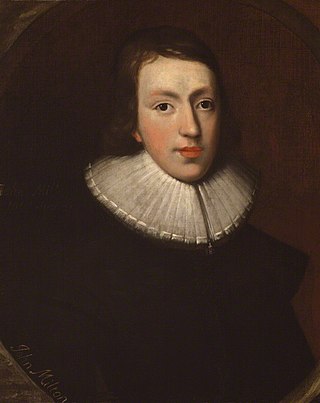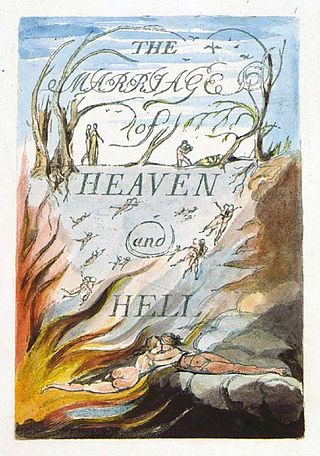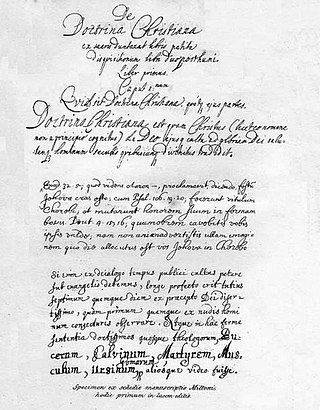External links
- Book 1 of Paradise Lost, Archived 2010-04-07 at the Wayback Machine from the Milton Reading Room.
An argument in literature is a brief summary, often in prose, of a poem or section of a poem or other work. It is often appended to the beginning of each chapter, book, or canto. They were common during the Renaissance as a way to orient a reader within a large work.
John Milton included arguments for each of the twelve books of the second edition of Paradise Lost , published in 1674 (the original ten-book edition of 1667 did not include them). They present a concise but often simplified account of what happens in the book, though they seem not to be intended to have interpretive value, and they have been only sporadically referenced by critics. The first begins:
The argument could also be in verse, as in Ludovico Ariosto's Orlando Furioso or William Blake's The Marriage of Heaven and Hell. Most arguments included in poems are written by the authors themselves, but in other cases they could be added subsequently by a printer or publisher to an earlier work.
An example of modern literature using this technique is Vikram Seth's A Suitable Boy (1993), where each of the 19 sections are described by a rhyming couplet on the table of contents.

John Milton was an English poet and intellectual. His 1667 epic poem Paradise Lost, written in blank verse and including over ten chapters, was written in a time of immense religious flux and political upheaval. It addressed the fall of man, including the temptation of Adam and Eve by the fallen angel Satan and God's expulsion of them from the Garden of Eden. Paradise Lost elevated Milton's reputation as one of history's greatest poets. He also served as a civil servant for the Commonwealth of England under its Council of State and later under Oliver Cromwell.

Sir William Empson was an English literary critic and poet, widely influential for his practice of closely reading literary works, a practice fundamental to New Criticism. His best-known work is his first, Seven Types of Ambiguity, published in 1930.

Paradise Lost is an epic poem in blank verse by the 17th-century English poet John Milton (1608–1674). The first version, published in 1667, consists of ten books with over ten thousand lines of verse. A second edition followed in 1674, arranged into twelve books with minor revisions throughout. It is considered to be Milton's masterpiece, and it helped solidify his reputation as one of the greatest English poets of all time. The poem concerns the biblical story of the fall of man: the temptation of Adam and Eve by the fallen angel Satan and their expulsion from the Garden of Eden.

Leviathan is a sea serpent noted in theology and mythology. It is referenced in several books of the Hebrew Bible, including Psalms, the Book of Job, the Book of Isaiah, the Book of Amos, and, according to some translations, in the Book of Jonah; it is also mentioned in the Book of Enoch. The Leviathan is often an embodiment of chaos and threatening to eat the damned after their life. In the end, it is annihilated. Christian theologians identified Leviathan with the demon of the deadly sin envy. According to Ophite diagrams, the Leviathan encapsulates the space of the material world.

The Marriage of Heaven and Hell is a book by the English poet and printmaker William Blake. It is a series of texts written in imitation of biblical prophecy but expressing Blake's own intensely personal Romantic and revolutionary beliefs. Like his other books, it was published as printed sheets from etched plates containing prose, poetry, and illustrations. The plates were then coloured by Blake and his wife Catherine.

Paradise Regained is a poem by English poet John Milton, first published in 1671. The volume in which it appeared also contained the poet's closet drama Samson Agonistes. Paradise Regained is connected by name to his earlier and more famous epic poem Paradise Lost, with which it shares similar theological themes; indeed, its title, its use of blank verse, and its progression through Christian history recall the earlier work. However, this effort deals primarily with the temptation of Christ as recounted in the Gospel of Luke.
The Life of Adam and Eve, also known in its Greek version as the Apocalypse of Moses, is a Jewish apocryphal group of writings. It recounts the lives of Adam and Eve from after their expulsion from the Garden of Eden to their deaths. It provides more detail about the Fall of Man, including Eve's version of the story. Satan explains that he rebelled when God commanded him to bow down to Adam. After Adam dies, he and all his descendants are promised a resurrection.
The prophetic books of the English poet and artist William Blake contain an invented mythology, in which Blake worked to encode his spiritual and political ideas into a prophecy for a new age. This desire to recreate the cosmos is the heart of his work and his psychology. His myths often described the struggle between enlightenment and free love on the one hand, and restrictive education and morals on the other.
The Second Book of Enoch is a pseudepigraphic text in the apocalyptic genre. It describes the ascent of the patriarch Enoch, ancestor of Noah, through ten heavens of an Earth-centered cosmos. The Slavonic edition and translation of 2 Enoch is of Christian origin in the 8th century but is based on an earlier work. 2 Enoch is distinct from the Book of Enoch, known as 1 Enoch, and there is also an unrelated 3 Enoch, although none of the three books are considered canonical scripture by the majority of Jewish or Christian bodies. The numbering of these texts has been applied by scholars to distinguish each from the others.

The State of Innocence is a dramatic work by John Dryden, originally intended as the libretto to an opera. It was written around 1673–4, and first published in 1677. The work is a rhymed adaption of John Milton's epic poem Paradise Lost, and retells the Biblical story of the fall of man.
Milton's Prosody, with a chapter on Accentual Verse and Notes is a book by Robert Bridges. It was first published by Oxford University Press in 1889, and a final revised edition was published in 1921.

The term Hexameron refers either to the genre of theological treatise that describes God's work on the six days of creation or to the six days of creation themselves. Most often these theological works take the form of commentaries on Genesis. As a genre, hexameral literature was popular in the early church and medieval periods. The word derives its name from the Greek roots hexa-, meaning "six", and hemer-, meaning "day".

Genesis B, also known as The Later Genesis, is a passage of Old English poetry describing the Fall of Satan and the Fall of Man, translated from an Old Saxon poem known as the Old Saxon Genesis. The passage known as Genesis B survives as an interpolation in a much longer Old English poem, the rest of which is known as Genesis A, which gives an otherwise fairly faithful translation of the biblical Book of Genesis. Genesis B comprises lines 235-851 of the whole poem.

Milton's 1645 Poems is a collection, divided into separate English and Latin sections, of John Milton's youthful poetry in a variety of genres, including such notable works as An Ode on the Morning of Christ's Nativity, Comus and Lycidas. Appearing in late 1645 or 1646, the octavo volume, whose full title is Poems of Mr. John Milton both English and Latin, compos'd at several times, was issued by the Royalist publisher Humphrey Moseley. In 1673, a year before his death, Milton issued a revised and expanded edition of the Poems.
Paradise Lost has had a profound impact on writers, artists and illustrators, and, in the twentieth century, filmmakers.

In the New Testament of the Christian Bible, the Book of Revelation describes a past war in heaven between angels led by the Archangel Michael against those led by "the dragon", identified as the devil or Satan, who was defeated and thrown down to the earth. Revelation's war in Heaven is related to the idea of fallen angels, and possible parallels have been proposed in the Hebrew Bible and the Dead Sea Scrolls.

Europe a Prophecy is a 1794 prophetic book by the British poet and illustrator William Blake. It is engraved on 18 plates, and survives in just nine known copies. It followed America a Prophecy of 1793.

Christ and Satan is an anonymous Old English religious poem consisting of 729 lines of alliterative verse, contained in the Junius Manuscript.

De Doctrina Christiana is a theological treatise of the English poet and thinker John Milton (1608–1674), containing a systematic exposition of his religious views. The Latin manuscript "De Doctrina" was found in 1823 and published in 1825. The authorship of the work is debatable. In favor of the theory of the non-authenticity of the text, comments are made both over its content, as well as since it is hard to imagine that such a complex text could be written by a blind person However, after nearly a century of interdisciplinary research, it is generally accepted that the manuscript belongs to Milton. The course of work on the manuscript, its fate after the death of the author, and the reasons for which it was not published during his lifetime are well established. The most common nowadays point of view on De Doctrina Christiana is to consider it as a theological commentary on poems.

A Vision of the Last Judgement is a painting by William Blake that was designed in 1808 before becoming a lost artwork. The painting was to be shown in an 1810 exhibition with a detailed analysis added to a second edition of his Descriptive Catalogue. This plan was dropped after the exhibition was cancelled, and the painting disappeared. Blake's notes for the Descriptive Catalogue describe various aspects of the work in a detailed manner, which allow the aspects of the painting to be known. Additionally, earlier designs that reveal similar Blake depiction of the Last Judgement have survived, and these date back to an 1805 precursor design created for Robert Blair's The Grave. In addition to Blake's notes on the painting, a letter written to Ozias Humphrey provides a description of the various images within an earlier design of the Last Judgement.